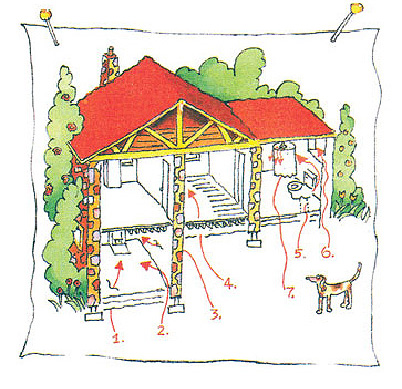Where Is Radon Found?
Radon is a natural product of the environment and the principal natural-background, radiation exposure source in the United States (Krewski et al. 2005).
- Radon gas moves freely through the air, groundwater, and surface water.
- The main source of indoor radon gas infiltration is from soil into buildings.
Due to radon progeny’s charged state and solid nature, they rapidly attach to most surfaces they encounter, including airborne particles (e.g., dust), walls, floors, ventilation equipment, and clothing.
Increased levels of radon have been identified in every state.
Only special equipment can detect or measure radon in the home and in the environment. In 2006, the American Cancer Society estimated 8 million homes in the United States had increased radon levels (ACS 2006). The U.S. Environmental Protection Agency (EPA) estimates that approximately 6 million homes have concentrations of radon above 4 picocuries per liter (pCi/L) (EPA 2009c).
Radon gas is a ubiquitous element found in rock and soil. The burning of coal and other fossil fuels also releases radon.
When radon escapes from soil or is discharged from emission stacks to the outdoor air, it is diluted to levels that are normally, but not always, lower than indoor air.
Radon gas in rocks and soil can move to air, groundwater, and surface water. Radon may also enter homes through the water supply.
The concentration of radon in water from wells may be higher than that from surface sources. Compared with surface water, groundwater tends to have more direct and longer contact with rocks and soil, allowing more of the uranium and thorium decay chain progeny to leach out.
- This may cause increased radon concentrations, especially when the water passes through areas rich in uranium and thorium, such as in Canada and northern New England.
- In typical municipal water or surface reservoirs, most of the radon volatizes to air or decays before the water reaches homes. Decay of the uranium and radium in that water results in only a small amount of residual radon.
Radon is also present in natural gas. Natural gas had previously been in contact with underground uranium and thorium-bearing rock and soil that continually release radon. The radon and its progeny remain with the natural gas as it travels through distribution pipes and into homes. Radon and its progeny are released to breathing air when the gas is burned in
- Fireplaces,
- Furnaces,
- Heaters,
- Stoves, and
- Water heaters.
Every state in the United States has homes with measured radon levels above the EPA recommended concentration.
- All homes should be tested regardless of geographic location.
- Homes with increased levels of radon have been found in all zones.
Radon can enter the home through
- Diffusion from the ground,
- Gas appliances, even if they are properly vented,
- Pressure-driven flow of air in the home—the most important mechanism—and
- Water supply, especially from private wells.
The pressure-driven mechanism occurs when radon escaping the soil encounters a negative pressure in the home relative to the soil. This pressure differential is caused by
- Exhaust fans (kitchen, bathroom, and clothes dryers), and
- Rising warm air created by
- Fireplaces,
- Furnaces,
- Ovens, and
- Stoves
Basements and crawl spaces under the houses allow more opportunity for entry of radon gas from soil.
The U.S. Environmental Protection Agency (EPA) estimates that 6%, or approximately 6 million U.S. homes, have concentrations of radon above 4 picocuries per liter (pCi/L) (EPA 2009c).
Radon gas can enter a building and then become trapped indoors. This can especially occur during a temperature inversion, which reduces radon’s escape potential from a building and thereby increases the indoor radon level.
The following list and graphics were extracted from EPA 2009, A Citizen’s Guide to Radon, http://www.epa.gov/radon/pubs/citguide.html (accessed 4-24-2010).
Radon can enter the home through
- Cracks in solid floors
- Construction joints
- Cracks in walls
- Gaps in suspended floors
- Gaps around service pipes
- Cavities inside walls
- Gas appliances
Figure 1. Sources of Radon and Common Entry Points

Radon is also released from materials inside the homes, such as
- Brick and mortar,
- Cinder block walls,
- Concrete floors,
- Gravel for heat sumps,
- Sheet rock, and
- Stone products.
Cooking with a gas stove and showering are household activities during which radon may be released from gas and water to the air (see water and natural gas above).
The U.S. Congress has mandated that each state set up an office to deal with requests for radon assistance. Many states provide free-of-charge radon detection kits such as the charcoal canister.
The amount of radon emanating from the earth and concentrating inside homes varies considerably by region and locality. In 1988, EPA and the Office of the Surgeon General jointly recommended that all U.S. homes below the third floor be tested for radon.
- Currently, the only way to determine indoor radon concentration is by measuring it.
- Radon only needs to be measured in inhabited areas of homes.
Measurement is the key to identifying the problem.
- “Do–it-yourself” radon detection kits are available in most hardware stores.
- Radon testing can also be done through a radon detection and remediation company.
Radon testing is required for all government buildings.
Additional information is available in Annex I on “Homes and Buildings,” “Methods of Detection,” “Real Estate Transactions,” and “EPA Map of Radon Zones.”
- The main source of indoor radon is radon gas infiltration from soil into buildings.
- Rock and soil produce radon gas.
- Building materials, the water supply, and natural gas can all be sources of radon in the home.
- Basements allow more opportunity for soil gas entry than slab-on-grade foundations.
- Showering and cooking can release radon into the air by aerosolizing household water (from a well) and burning natural gas.
- Currently, testing is the only way to determine indoor radon concentration.